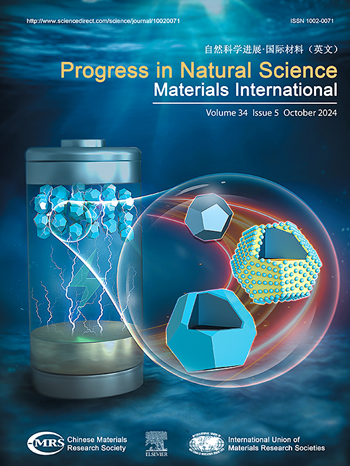3C-SiC的取向依赖性变形和弹出行为
IF 7.1
2区 材料科学
Q2 MATERIALS SCIENCE, MULTIDISCIPLINARY
Progress in Natural Science: Materials International
Pub Date : 2025-06-01
DOI:10.1016/j.pnsc.2025.03.003
引用次数: 0
摘要
了解晶体取向与变形行为之间的关系对于优化3C-SiC在高级应用中的机械性能至关重要。本文采用纳米压痕实验、高分辨率透射电子显微镜(HRTEM)和分子动力学(MD)模拟,系统研究了晶体取向对3C-SiC弹塑性变形行为的影响。在(001)和(111)晶体平面上都观察到了弹出事件,(111)平面比(001)平面表现出更高的临界弹出载荷。纳米压痕试验进一步表明,(111)平面比(001)平面具有更高的弹性模量和纳米硬度。HRTEM分析表明,弹出行为主要受位错滑动活动控制。在两个方向的压痕下都观察到{111}滑移面上的位错滑移,而在(111)平面上观察到{001}滑移面上额外的位错滑移,具有边缘位错的特征。MD模拟证实了类似的位错活动,并揭示了高应力集中区域的非晶化。非晶化进一步显示在两个晶体平面的剪切带区域内发生。本文章由计算机程序翻译,如有差异,请以英文原文为准。
Orientation-dependent deformation and pop-in behavior in 3C-SiC
Understanding the relationship between crystal orientation and deformation behavior is critical for optimizing the mechanical performance of 3C-SiC in advanced applications. Here, the effect of crystal orientation on elasto-plastic deformation behavior in 3C-SiC was systematically studied using nanoindentation experiments, high-resolution transmission electron microscopy (HRTEM), and molecular dynamics (MD) simulations. Pop-in events were experimentally observed on both the (001) and (111) crystallographic planes, with the (111) plane exhibiting a higher critical pop-in load than the (001) plane. Nanoindentation tests further revealed that the (111) plane has a higher elastic modulus and nanohardness compared to the (001) plane. HRTEM analysis showed that the pop-in behavior is primarily governed by dislocation slip activity. Dislocation slip on the {111} slip plane was observed beneath the indentation for both orientations, while additional dislocation slip on the {001} slip plane, characteristic of edge dislocations, was noted for the (111) plane. MD simulations confirmed similar dislocation activity and revealed amorphization in regions of high stress concentration. Amorphization was further shown to occur within shear band zones in both crystallographic planes.
求助全文
通过发布文献求助,成功后即可免费获取论文全文。
去求助
来源期刊
CiteScore
8.60
自引率
2.10%
发文量
2812
审稿时长
49 days
期刊介绍:
Progress in Natural Science: Materials International provides scientists and engineers throughout the world with a central vehicle for the exchange and dissemination of basic theoretical studies and applied research of advanced materials. The emphasis is placed on original research, both analytical and experimental, which is of permanent interest to engineers and scientists, covering all aspects of new materials and technologies, such as, energy and environmental materials; advanced structural materials; advanced transportation materials, functional and electronic materials; nano-scale and amorphous materials; health and biological materials; materials modeling and simulation; materials characterization; and so on. The latest research achievements and innovative papers in basic theoretical studies and applied research of material science will be carefully selected and promptly reported. Thus, the aim of this Journal is to serve the global materials science and technology community with the latest research findings.
As a service to readers, an international bibliography of recent publications in advanced materials is published bimonthly.

 求助内容:
求助内容: 应助结果提醒方式:
应助结果提醒方式:


